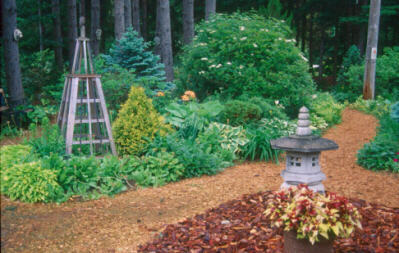|
Conifers score points for gardens By MARJORIE HARRIS You'd think the most natural thing Canadians could do is to put evergreens in their gardens. But not necessarily so. Certainly not in the experience of David Dunn and Robert Caron of Rideau Woodland Ramble outside Merrickville, southwest of Ottawa. This nursery specializes in tough, hardy and unusual evergreens. "I can always tell the Europeans when they visit," Caron says. "They'll head straight for the conifers." Our reluctance stems partly from how badly conifers have been used in the past. Look at all those bitty houses overwhelmed by gigantic blue spruces. They may have been tiny 30 years ago, but today these trees are 15 or 20 metres tall, with huge skirts that make any home gloomy. Or the clichéd foundation plantings that include a pointy evergreen at the edges and three round ones smack dab in front of the living room window. "What most people don't realize," Dunn says, "is just how much variation there is in the texture, colour and form of conifers." That's an understatement. I saw their display at the Kanata Plant & Garden Show in the spring and immediately had to have one of their blue pines. My Pinus flexilis 'Extra Blue' has long, intensely blue needles that look strangely soft and inviting. It's small now, sitting in full sun against a background of deep green clematis, but it will grow to 10 metres, which is about right for the space. Siting conifers is where most people go wrong. We tend to put golden evergreens in shady spots to perk things up and wonder why they revert to green. Gold needs sun. Dunn and Caron combine conifers with hostas and hydrangeas. They are also magnificent with ornamental grasses. The palette of the new conifers is dazzling. Lustrous greens include white cedar, or Thuja occidentalis 'Lyonsville', a ball of foliage that grows to a metre square. The glossy green Japanese umbrella pine, or Sciadopitys, grows to 10 metres. Among the new dwarf plants in the golden range is 'Taylor's Sunburst', a lodgepole pine with bright golden-yellow candles in spring (they mature to yellow-green) that grows to five metres. Golden groundcovers are no slouches: Juniper horizontalis 'Lime Glow' has feathery chartreuse foliage when it's young. 'Mother Lode' is a bright yellow that holds its colour even in partial sun, and becomes deep orange yellow with a plum tinge in winter. Japanese stone pine, Pinus pumila 'Blue Dwarf', is a dense horizontal spreader with intense blue colour that grows to two metres. There are even two-toned conifers: Picea abies 'Rubra Spicata' has red new growth which changes to red brown then green. Pinus sylvestris 'Slim Jim' is a wonderful pine for a small garden, with twisted dark green old needles backing up new light coloured growth. With plenty of cool, wet weather, autumn is the best time to plant conifers and give them a head start on next spring. Caron and Dunn stress the need for them to go into winter well-hydrated. That means pouring buckets of water around them right up to the first hard frost. And we shouldn't be pruning them after this week, because any new growth will be weak. The importance of conifers in the garden should be obvious: For three seasons, they shine. In spring, they put on new growth that may be golden or lime green or red; in autumn, they will stand in contrast with the fiery changes of deciduous leaves, and in winter, of course, they become the focal point. Conifers give structure to a garden that no other plant can. Marjorie Harris is editor-in-chief of Gardening Life magazine. Visit http://www.marjorieharris.com. |
